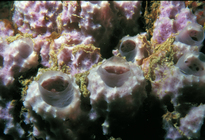 |
 |
|
|
||
Porifera taxon detailsDysidea lehnerti Van Soest & Hooper, 2020
1424371 (urn:lsid:marinespecies.org:taxname:1424371)
accepted
Species
Dysidea tubulata (Lehnert & van Soest, 1998) · unaccepted (preoccupied)
Hyrtios tubulatus Lehnert & van Soest, 1998 · unaccepted (genus transfer and preoccupied)
marine,
recent only
Van Soest, R.W.M.; Hooper, J.N.A.; Butler, P.J. (2020). Every sponge its own name: removing Porifera homonyms. <em>Zootaxa.</em> 4745(1): 1-93., available online at https://doi.org/10.11646/zootaxa.4745.1.1
page(s): 61 [details] Available for editors
Nomenclature We cite here Van Soest et al.'s (202: 61) explanation for the nomen novum.
Removal of homonymy between Dysidea tubulata†...
Nomenclature We cite here Van Soest et al.'s (202: 61) explanation for the nomen novum. Removal of homonymy between Dysidea tubulata† Rutot, 1874 and Dysidea tubulata (Lehnert & Van Soest, 1998). 1. Dysidea? tubulata† Rutot, 1874: 66 (type locality Eocene strata near Brussels, Belgium). The description of the fossil material (without illustrations of the habitus, just some unidentifiable calcareous microfossils) throws some doubt on the membership of the genus Dysidea, but without subsequent studies the combination remains valid as a senior secondary homonym of D. tubulata (Lehnert & Van Soest, 1998) (ICZN Art. 57.3). 2. Hyrtios tubulatus Lehnert & Van Soest, 1998: 95 (type locality Discovery Bay, Jamaica). The species was originally described from dried material preventing proper recognition of the in situ features. Later, in situ specimens and chemistry (e.g. Salmoun et al. 2000: 452) made it likely that the species fits much better in Dysidea, and it is accordingly transferred here (but already mentioned in Shady et al. (2017: 2), and in the World Porifera Database) to Dysidea tubulata. It was later realized that the combination was already occupied by a fossil, creating a junior secondary homonym that needed to be replaced (ICZN Art. 60.3). 3. Summary: Dysidea tubulata Rutot, 1874 is to be maintained as a senior secondary homonym (ICZN Art. 57.3). Dysidea tubulata (Lehnert & Van Soest, 1998) as a junior secondary homonym needed to be replaced, for which Dysidea lehnerti nom. nov. was proosed, named after Helmut Lehnert (ICZN Art. 60.3). [details]
de Voogd, N.J.; Alvarez, B.; Boury-Esnault, N.; Cárdenas, P.; Díaz, M.-C.; Dohrmann, M.; Downey, R.; Goodwin, C.; Hajdu, E.; Hooper, J.N.A.; Kelly, M.; Klautau, M.; Lim, S.C.; Manconi, R.; Morrow, C.; Pinheiro, U.; Pisera, A.B.; Ríos, P.; Rützler, K.; Schönberg, C.; Turner, T.; Vacelet, J.; van Soest, R.W.M.; Xavier, J. (2024). World Porifera Database. Dysidea lehnerti Van Soest & Hooper, 2020. Accessed at: https://www.marinespecies.org/porifera/porifera.php?p=taxdetails&id=1424371 on 2024-04-19
Date action by
original description
Van Soest, R.W.M.; Hooper, J.N.A.; Butler, P.J. (2020). Every sponge its own name: removing Porifera homonyms. <em>Zootaxa.</em> 4745(1): 1-93., available online at https://doi.org/10.11646/zootaxa.4745.1.1
page(s): 61 [details] Available for editors original description (of Dysidea tubulata (Lehnert & van Soest, 1998)) Lehnert, H.; van Soest, R.W.M. (1998). Shallow water sponges of Jamaica. <em>Beaufortia.</em> 48 (5): 71-103. [details] original description (of Hyrtios tubulatus Lehnert & van Soest, 1998) Lehnert, H.; van Soest, R.W.M. (1998). Shallow water sponges of Jamaica. <em>Beaufortia.</em> 48 (5): 71-103. page(s): 95 [details] additional source (of Hyrtios tubulatus Lehnert & van Soest, 1998) Shady, N.; El-Hossary, E.; Fouad, M.; Gulder, T.; Kamel, M.; Abdelmohsen, U. (2017). Bioactive Natural Products of Marine Sponges from the Genus <i>Hyrtios</i>. <em>Molecules.</em> 22(5): 781., available online at https://doi.org/10.3390/molecules22050781 [details] Available for editors additional source (of Hyrtios tubulatus Lehnert & van Soest, 1998) Salmoun, M.; Devijver, C.; Daloze, D.; Braekman, J.C.; Gomez, R.; De Kluijver, M.; Van Soest, R.W.M. (2000). New sequiterpene/quinones from two sponges of the genus <i>Hyrtios</i>. <em>Journal of Natural Products.</em> 63 (4): 452-456. page(s): 455 [details] Available for editors new combination reference (of Hyrtios tubulatus Lehnert & van Soest, 1998) Van Soest, R.W.M.; Hooper, J.N.A.; Butler, P.J. (2020). Every sponge its own name: removing Porifera homonyms. <em>Zootaxa.</em> 4745(1): 1-93., available online at https://doi.org/10.11646/zootaxa.4745.1.1 page(s): 61 [details] Available for editors new combination reference (of Dysidea tubulata (Lehnert & van Soest, 1998)) Shady, N.; El-Hossary, E.; Fouad, M.; Gulder, T.; Kamel, M.; Abdelmohsen, U. (2017). Bioactive Natural Products of Marine Sponges from the Genus <i>Hyrtios</i>. <em>Molecules.</em> 22(5): 781., available online at https://doi.org/10.3390/molecules22050781 [details] Available for editors  Present Present  Inaccurate Inaccurate  Introduced: alien Introduced: alien  Containing type locality Containing type locality
From editor or global species database
Nomenclature We cite here Van Soest et al.'s (202: 61) explanation for the nomen novum.Removal of homonymy between Dysidea tubulata† Rutot, 1874 and Dysidea tubulata (Lehnert & Van Soest, 1998). 1. Dysidea? tubulata† Rutot, 1874: 66 (type locality Eocene strata near Brussels, Belgium). The description of the fossil material (without illustrations of the habitus, just some unidentifiable calcareous microfossils) throws some doubt on the membership of the genus Dysidea, but without subsequent studies the combination remains valid as a senior secondary homonym of D. tubulata (Lehnert & Van Soest, 1998) (ICZN Art. 57.3). 2. Hyrtios tubulatus Lehnert & Van Soest, 1998: 95 (type locality Discovery Bay, Jamaica). The species was originally described from dried material preventing proper recognition of the in situ features. Later, in situ specimens and chemistry (e.g. Salmoun et al. 2000: 452) made it likely that the species fits much better in Dysidea, and it is accordingly transferred here (but already mentioned in Shady et al. (2017: 2), and in the World Porifera Database) to Dysidea tubulata. It was later realized that the combination was already occupied by a fossil, creating a junior secondary homonym that needed to be replaced (ICZN Art. 60.3). 3. Summary: Dysidea tubulata Rutot, 1874 is to be maintained as a senior secondary homonym (ICZN Art. 57.3). Dysidea tubulata (Lehnert & Van Soest, 1998) as a junior secondary homonym needed to be replaced, for which Dysidea lehnerti nom. nov. was proosed, named after Helmut Lehnert (ICZN Art. 60.3). [details] |
